Lettre d’information de l’Ifao
Janvier 2024
Rubriques : (-) À la une (-) Quelques questions à Pierre Grandet... (-) Le carnet de l'Ifao (-) Manifestations scientifiques (-) Rencontres scientifiques (-) Sur la chaîne Youtube de l'Ifao (-) Publications

◼︎ Photo du personnel de l'Ifao, janvier 2024 © M. Kačičnik/Ifao.
À la Une
|
Les derniers mois de l'année 2023 ont été particulièrement marquants. L'équipe s'est renouvelée et enrichie, notamment l'équipe de direction. Pierre Tallet a succédé à Laurent Coulon comme directeur de l'Ifao le 1er septembre. La secrétaire générale, Catherine Lion-Josserand, a quitté l'institut après près de sept ans d'investissement sans faille en novembre ; Yann Hervo lui a succédé. La nomination, en juin, de Pierre Tallet au poste de directeur de l'Ifao s'inscrit dans la continuité de son parcours. A bien des égards, il s'agit d'un retour, pour un égyptologue qui a noué, depuis ses premiers pas en Egypte au début des années 1990, une relation particulière avec ce pays. Ancien responsable des publications de l'Ifao, Pierre Tallet a participé de façon décisive à son rayonnement, en particulier via ses travaux sur les rives de la mer Rouge. Egyptologue de renommée mondiale, il est titulaire de la chaire d'égyptologie de Sorbonne université et correspondant de l'Académie des Inscriptions et Belles-Lettres. Par ailleurs, il a dirigé l'UMR 8167 Orient et Méditerranée de 2019 à 2023. Le palais s'est aussi enrichi du renforcement des liens anciens qui unissent l'Institut et la Section française des Antiquités du Soudan (SFDAS). La directrice de la SFDAS, Séverine Marchi, et sa chercheuse, Faiza Drici, y sont accueillies depuis le mois de décembre du fait de la guerre que connaît le Soudan. La fin de l'année a aussi été marquée par une activité scientifique très riche. Treize missions archéologiques ont eu lieu de septembre à décembre 2023. Un nouveau séminaire, organisé conjointement avec le Deutsches Archäologisches Institut Kairo, a été lancé en septembre : "Exploring Egypt Seminar: Histories and Historiographies" ; il invite les chercheurs à réfléchir aux modalités de la production du savoir en Egypte, du XIXe siècle à nos jours. Résolument pluridisciplinaire et transversal, le séminaire est piloté par Fatma Keshk, postdoctorante égyptologue, et par Malak Labib, historienne de l'Egypte contemporaine et membre scientifique de l'Ifao. La même approche pluridisicipilinaire a présidé à la tenue, à l'Ifao, du symposium "Reading reuse. Image recycling in Egypt and beyond", organisé par deux membres scientifiques, Axelle Brémont et Simon Connor, ainsi que par Vera Elizabeth Allen, doctorante de l'université de Bâle et de Harvard. Pendant quatre jours, du 30 octobre au 2 novembre, les chercheurs ont pu travailler, en présence d'un public nombreux, sur le thème du remploi des images dans l’art. En parallèle et en dialogue avec ce symposium, une exposition s'est tenue dans le grand hall de l'institut, à laquelle ont participé dix artistes vivant au Caire. Au même moment, paraissait Costumes of Egypt. The lost legacies que l'autrice, Shahira Mehrez, a présenté au Musée National de la Civilisation (NMEC), le 23 octobre, et à l'Ifao, le 6 novembre. Là encore, un public nombreux s'est pressé dans le palais pour découvrir un ouvrage attendu de longue date, qui a immédiatement connu un grand succès.
◼︎ Fouilles du village de Ghozza, mission archéologique du Désert oriental, janvier 2024 (© A. Bahgat/Ifao)
كانت الأشهر الأخيرة من عام ٢٠٢٣ ديناميكية بشكل استثنائي. لقد تم تجديد وإثراء طاقم العمل، وخاصة فريق الإدارة. بدأ بيير تاليه عمله كمدير للمعهد في بداية سبتمبر. وغادرت السكرتيرة العامة كاثرين ليون-جوسراند المعهد في ديسمبر بعد حول سبع سنوات من العمل الدؤوب وخلفها يان إيرفو. إن وصول بيير تاليه إلى فريق المعهد في يونيو كمدير جديد للمعهد يتماشى مع استمرارية مسيرته المهنية من نواحٍ عدة، يعد هذا بمثابة عودة لباحث المصريات ذو العلاقة الخاصة مع مصر منذ أول مهمة له في أوائل التسعينيات. وقد لعب بيير تاليه، الذي كان يشغل سابقًا منصب رئيس قسم التحرير في المعهد، دورًا رئيسيًا في تطويرها، خاصة من خلال عمله في منطقة البحر الأحمر. وهو باحث في علم المصريات مشهور عالميًا، ويشغل منصب رئيس قسم علم المصريات بجامعة السوربون، وهو مراسل علمي لأكاديمية النقوش والآداب، كما قام بإدارة UMR 8167 Orient et Méditerranée في الفترة من ٢٠١٩ حتى ٢٠٢٣. كما ازداد قصرالمنيرة ثراءً بتعزيز العلاقات التي تجمع المعهد والقسم الفرنسي لآثار السودان(SFDAS) ، حيث تم استقبال المديرة، سيفرين مارشي، والباحثة فايزة دريسي بسبب الأحداث الحالية بالسودان. لقد كانت نهاية السنة الماضية غنية بالنشاط العلمي حيث قامت ١٣ بعثة حفائر أثرية بالعمل بمواقعها المختلفة بدءً من سبتمبر حتى ديسمبر ٢٠٢٣. كذلك شهدنا اطلاق سلسلة ندوات جديدة يتم تنظيمها بالاشتراك مع المعهد الألماني للآثار بالقاهرة، بدءا من سبتمبر وهي "استكشاف مصر: التاريخ والتأريخ"؛ وهي تدعو الباحثين إلى إعادة النظر في طرق صناعة المعرفة في مصر من القرن التاسع عشر وحتى اليوم. تتميز الندوة بأنها متعددة التخصصات، وقد تم تنظيمها من قبل فاطمة كشك، الحاصلة على درجة الدكتوراه في مصر، وملك لبيب، المتخصصة في تاريخ مصر المعاصر والعضوة العلمية في المعهد. تم تطبيق هذه الطريقة البحثية متعددة التخصصات أيضًا في مؤتمر "Reading reuse. Image recycling in Egypt and beyond"، والتي نظمها العضوان العلميان، أكسيل بريمون وسيمون كونور، بالإضافة إلى فيرا إليزابيث ألين، من جامعة بازل، لمدة أربعة أيام، في الفترة من ٣٠ أكتوبر إلى ٢ نوفمبر٢٠٢٣، حيث قام الباحثون بمناقشة وتحليل إعادة استخدام الصور في الفن القديم. بالتوازي مع المؤتمر، استضاف المعهد معرض فني في البهو الكبير، حيث شارك فيه فنانون عدة من القاهرة. وفي نفس التوقيت تم مناقشة وعرض كتاب (Costumes of Egypt. The lost legacies)، للباحثة الكبيرة شهيرة محرز في المتحف القومي للحضارة (NMEC) يوم ٢٣ أكتوبر، وفي المعهد يوم ٦ نوفمبر. وهنا مرة أخرى، توافد جمهور كبير على القصر لاكتشاف العمل الذي طال انتظاره، والذي أثبت نجاحه بشكل كبير. |
◼︎ Yann Hervo succède à Catherine Lion-Josserand comme secrétaire général en novembre 2023. ◼︎ La Section française des Antiquités du Soudan (SFDAS) est accueillie à l'Ifao.
◼︎ Parution de 'Costumes of Egypt', par Shahira Mehrez, avec deux conférences publiques au NEMEC et à l'Ifao.
◼︎ 2e séance du séminaire "Exploring Egypt" en coopération avec le DAIK, par Dina Bakhoum à l'Ifao le 3 décembre |
Quelques questions à Pierre Grandet..
|
Égyptologue, spécialiste du Nouvel Empire et de l’écriture hiératique, Pierre Grandet est chargé de la publication de la collection des ostraca documentaires de l’Ifao depuis 1997. |
||
|
◼︎ Pierre Grandet |
||
1. Pierre Grandet et les ostraca de l’Ifao... Une relation de longue date... Comment a-t-elle commencé ?Je suis venu à l’Ifao pour la première fois au milieu des années 1980 grâce à une bourse postdoctorale du ministère des Affaires étrangères, essentiellement pour profiter de la bibliothèque et finaliser la publication de ma thèse. A l’époque, les chambres des missionnaires étaient à la place des salles des archives actuelles. Après plusieurs candidatures malheureuses pour devenir pensionnaire de l’Ifao, j’ai finalement été embauché par le Fonds Khéops pour l’archéologie comme chargé de cours. J'y ai passé l’essentiel de ma carrière. J’ai alors pu enseigner dans plusieurs universités (Angers, Poitiers et Lille), et, ainsi, j’ai pu continuer mes recherches, finalement avec beaucoup plus de liberté qu’en étant dans le cadre universitaire. Ma relation avec les ostraca de l’Ifao a commencé en 1997 quand Nicolas Grimal, alors directeur de l’Ifao, m’a chargé de la publication de la collection. J’avais en fait été introduit par Yvan Koenig, professeur de hiératique à l’EPHE qui, voulant se consacrer aux papyrus et connaissant mes centres d’intérêt, m’avait recommandé. Depuis, je viens chaque année, sauf en 2011 à cause de la révolution et en 2020 à cause de la pandémie de Covid. 2. Parmi les personnes que vous avez côtoyées au long de ces années, lesquelles vous ont marqué ?La liste serait longue, j’ai eu la chance d’avoir toujours bénéficié des meilleures conditions de travail à l’Ifao de manière générale avec l'aide du personnel des archives, du service photo et du pôle éditorial. Mais, si je dois citer quelqu’un, c’est Nicolas Grimal : lorsque j’ai demandé des gros travaux de réorganisation de la salle des collections des ostraca pour en faciliter l’accès et l’étude, il a immédiatement validé le projet, allant même au-delà de mes attentes en achetant du matériel, comme un monte-charge électrique que je n’avais pas osé demander. Il nous a vraiment donné les moyens de travailler. Il faut préciser qu'à l'époque les ostraca étaient stockés dans des meubles à tiroir dans une salle devenue aujourd'hui une salle de la bibliothèque qui d'ailleurs en porte toujours le nom bien que les collections aient déménagé.
|
||
3. Les collections des ostraca ont eu plusieurs vies à l’Ifao. Pouvez-vous nous en parler ?Effectivement, à cause de leur poids et de leur volume, elles ont toujours été un souci constant et un objet de réflexion. Plusieurs projets architecturaux ont été imaginés pour relocaliser les collections qui pesaient sur le bâtiment et empêchaient l’expansion de la bibliothèque. Plusieurs projets ont été pensés, mais ils n’ont jamais abouti. Ce n’est finalement qu’en 2011 que Nadine Cherpion, qui était alors à la tête du service des archives, a fait déplacer les ostraca dans une salle dédiée au sein du service. Malheureusement, la solution a été remise en cause, car les ostraca menaçaient la solidité du plancher de la salle. Finalement, les collections ont été définitivement déplacées dans la Salle 5 et dans l'Ostracothèque en mezzanine au-dessus du couloir de l'administration. Une partie du Palais dont le plancher est en béton. 4. Vous avez publié six volumes sur les collections et vous travaillez actuellement sur le septième. On dit volontiers que Pierre Grandet a, en quelque sorte, changé la manière de publier les ostraca. A quel point est-ce vrai ?J’ai poursuivi le travail de publication de la série des Catalogues des ostraca hiératiques non littéraires de Deir El Médineh commencé par Černý, puis poursuivi par Sauneron, dont le premier volume est paru en 1935. Le volume 8 est le premier volume que j’ai publié à mon nom. Ensuite, j'en ai signé six autres. Le septième est en cours de publication (il s'agira du volume 14 de cette série). A mon âge, je n’ai évidemment pas la prétention de pouvoir achever la publication de l'ensemble de la collection de l’Ifao, qui est conséquente. Je passerai sans doute le flambeau. Dans la discipline, la tradition était de publier les ostraca sans aucune traduction ni commentaire afin de ne pas influencer les autres chercheurs, mais j’ai décidé d’en doter mes publications, m'inspirant en fait d’autres disciplines. En effet, suite à mes échanges avec Jean luc Fournet et Hélène Cuvigny, je me suis beaucoup inspiré de leur manière de publier les ostraca grecs.
5. A votre avis, quel est l’avenir de ces collections ?A mon avis, il y a un conflit entre conservation et recherche : la logique de conservation a comme priorité de cataloguer et stocker le maximum d’objets en les isolant dans une enveloppe individuelle dans un minimum d’espace alors que, pour les besoins de la recherche, il serait préférable de pouvoir les étaler le plus largement possible de façon à pouvoir les raccorder ou les mettre en relation plus facilement. Or, cela s’avère plus difficile vu la manière actuelle de les conserver. J’ai toujours rêvé qu’on construise un petit bâtiment à même le sol, par exemple dans le jardin, afin que les ostraca ne soient enfin plus vus comme une menace pour la structure du Palais. |
|
|
|
لقاء ودي مع عالم المصريات المتخصص في عصر الدولة الحديثة والكتابة الهيراطيقية، بيير جرانديه والمسؤول عن نشر مجموعة الأوستراكا الوثائقية للمعهد الفرنسي للآثار الشرقية منذ عام 1997. ١. بيير جرانديه وأوستراكا المعهد الفرنسي للآثار الشرقية؛ علاقة طويلة الأمد... كيف بدأت؟
بدأت علاقتي مع الأوستراكا في عام ١٩٩٧ عندما كلفني نيكولا جريمال، مدير المعهد آنذاك، بنشر المجموعة. لقد تم تقديمي في الواقع من قبل إيفان كونيج، أستاذ الهيراطيقية في المدرسة العملية للدرسات العليا بباريس الذي قدم لي التوصية بعدرغبته في تكريس وقته للبرديات وتعرفة على اهتماماتي. منذ ذلك الحين وانا آتي إلي المعهد بشكل مستمر كل عام، باستثناء فترة ثورة ٢٠١١ وفي ٢٠٢٠ بسبب جائحة كوفيد ٢. من هم الأشخاص الذين تركوا علامة ممن عملت معهم على مر السنين؟
٤. لقد نشرت 6 مجلدات عن المجموعات وتعمل حاليا على المجلد السابع. يقال أن بيير غرانديه غيّر بطريقة ما طريقة نشر الأوستراكا. ما مدى صحة هذا؟
في هذا التخصص، كان التقليد هو نشر القطع دون أي ترجمة او تفسير حتى لا نؤثر على الباحثين الآخرين، لكنني قررت أن أرفق منشوراتي بالتعليقات والتفسيرات. ولهذا السبب استلهمت من التخصصات الأخرى. في الواقع، بعد مناقشاتي مع جان لوك فورنيه وهيلين كوفيني، ألهمتني كثيرًا طريقة نشرهم الأوستراكا اليونانية. ٥. برأيك ما هو مستقبل هذه المجموعات؟
تكوين مجموعات بطريقة تمكنك من ربطها بسهولة أكبر. ومع ذلك، يبدو أن هذا أكثر صعوبة؛ نظرا للطريقة الحالية للحفاظ عليها. لطالما حلمت ببناء منزل صغير على الأرض، في الحديقة مثلاً، حتى لا يُنظر إلى القطع على أنها تهديد للمبنى. |
||
Le carnet de l'Ifao
ArrivéesDeux membres scientifiques ont intégré l'Ifao : - Laura Aguer, papyrologue hélléniste. – Anna Lagaron, épigraphiste arabisante. Les chercheuses et chercheurs suivants ont rejoint l'Ifao : – Cristinà Alù, égyptologue, est lauréate de la bourse postdoctorale Ifao/PCMA. - Mohamed Ibrahim, médiéviste, Assistant Professor à l'université Ayn Shams, est désormais chercheur associé de l'Ifao. - Amany El-Naggar, céramologue, doctorante à l'Université Aïn Shams, est lauréate de la bourse doctorale de l'Ifao. Les agents suivants ont rejoint l'Ifao : - Yann Hervo est Secrétaire Général depuis novembre. - Florence Albert, ancienne responsable des publications et ancienne membre scientifique, occupe désormais le poste d'adjointe au chef du pôle éditorial, en charge de l'opérationnel. - Yassine Temlali, a rejoint l'Ifao comme Editeur (publications arabisantes). - Sarah Heiba a été recrutée comme assistante au pilotage scientifique. -Khaled Ali, façonneur et Mohamed Mohamed Hussein, relieur, ont rejoint l'équipe de l'imprimerie. انضم عضوان علميان إلى المعهد:- لورا أجييه، باحثة البرديات الهلنستية. - آنا لاجارون، باحثة نقوش عربية. وقد انضم الباحثون التاليون إلى المعهد: - كريستينا ألو، باحثة في علم المصريات، حاصلة على منحة ما بعد الدكتوراه المشتركة من Ifao/PCMA. - محمد اراهيم، باحث في العصور الوسطى، أستاذ مساعد بجامعة عين شمس، وهو الآن باحث مشارك في المعهد. - أماني النجار، أخصائية خزف، طالبة دكتوراه بجامعة عين شمس، حائزة على منحة المعهد للدكتوراه. انضم الأعضاء التاليون إلى المعهد:- تم تعيين يان هيرفو سكرتيرًا عامًا في نوفمبر. - فلورنس ألبرت، عضوة علمية سابقة في المعهد، وتشغل الآن منصب مساعد رئيس قسم التحرير، المسؤولة عن الإدارة التشغيلية. - انضم ياسين تملالي إلى المعهد كناشر (الدراسات العربية). - تم تعيين سارة هيبة كمساعدة للإدارة العلمية. -انضم خالد علي ومحمد محمد حسين لقسم تجليد،في مطبعة المعهد. Départs- Catherine Lion-Josserand, secrétaire générale, a quitté l'Ifao en novembre 2023. - Sabah Fawzy, a quitté l'imprimerie de l'Ifao. - تركت كاثرين ليون منصبها كسكرتيرة عامة في نوفمبر ٢٠٢٣. - غادرت صباح فوزي المطبعة بنهاية عقدها في أكتوبر ٢٠٢٣. |
◼︎ Laura Aguer |
◼︎ Anna Lagaron |
|
◼︎ Cristinà Alù
◼︎ Mohamed Ibrahim |
◼︎ Florence Albert
|
|
|
◼︎ Yassie Temlali |
◼︎ Sarah Heiba |
|
|
◼︎ Mohamed Hussein |
◼︎ Khaled Ali |
|
Manifestations scientifiques
 |
Cycle de conférences : Les conférences de l'Ifao |
|
|
|
|
Séminaire de recherche de l'Ifao |
|
|
|
|
Cycle de conférences : Égyptologie bi-l-ʿarabīOrganisé en partenariat avec "Al-Makân wa-l-Nâs" |
|
|
|
 |
Séminaire : "Qira'at"- Reading historical documents from Egypt, Medieval till modern times (سلسلة ندوات قراءآت )Organisé par Prof. Magdi Guirguis |
|
|
|
|
Seminar 'Conversations about Nomadism' |
|
|
|
|
Exploring Egypt Seminar: Histories and HistoriographiesEn partenariat avec DAIK |
|
|
 |
Les rendez-vous de l’archéologieEn partenariat avec l’IFE |
|
|
|
|
Overview of Current Research in the Eastern Mediterranean During the First and Second Millennia BC MouniraEn partenariat avec IFEA, IFPO & EFA |
|
|
|
|
Présentation d’ouvrage |
|
|
Formations
 |
Le 30 septembre 2023, Formation par Mathilde Prevost & Bassem Gihad: Akhet Seminar on current developments and methods in Ancient Egyptian history and archaeology, en partenariat avec le Central Traning Unit - MoTA [en savoir plus] |
|
 |
Du 1 au 5 octobre 2023, Les académies de l'Ifao pour jeunes chercheurs par Florence Albert, Annie Gasse et Nathalie Sojic: 7e Académie Hiératique, en partenariat avec l’ENiM, UMR 5140 – ASM, Université Montpellier 3 [en savoir plus] |
|
 |
Du 8 au 12 octobre 2023, Formation par Sylvie Marchand (IFAO) & Yahya Elshahat (université du Fayoum): Atelier d’écriture. Publier de la céramique., en partenariat avec le université du Fayoum [en savoir plus] |
|
 |
Le 15 octobre 2023, Formation par Hassan Sélim & Pierre Tallet: Scientific examination for Egyptian artefacts: Genuine or Fake ?, en partenariat avec le Faculty of Archaeology, Aïn Sham University [en savoir plus] |
|
  |
Le 14 novembre 2023, Les cours de l’Ifao par : Arts de vivre en Égypte ancienne [en savoir plus] |
|
 |
Le 23 novembre 2023, Formation par Pr. Ayman Fouad Sayed: دورة تدريبية في علم المخطوطات والنشر النقدي للنصوص ( نوفمبر- ديسمبر ٢٠٢٣) [en savoir plus] |
|
 |
Du 18 au 19 décembre 2023, Formation par Naglaa Hamdi Boutros & Ahmed ELnemr: كيف تكتب وتنشر بحثًا في الآثار الإسلامية والقبطية, en partenariat avec le MoTA (bureau scientifique) & Musée d'art islamique du Caire [en savoir plus] |
Exposition
 |
Du 30 octobre au 16 novembre 2023, Exposition par Vera Elizabeth Allen, Axelle Brémont & Simon Connor: REading REuse [en savoir plus] |
Événements exceptionnels
 |
Le 11 octobre 2023, Projection de documentaire par Petr Horký & Miroslav Bárta: Civilization. A good news about the end of the world. [en savoir plus] |
Rencontres scientifiques
 |
Du 30 octobre au 2 novembre 2023, Colloque international organisé par Vera Elizabeth Allen, Axelle Brémont & Simon Connor: Reading reuse. Image recycling in Egypt and beyond [en savoir plus] | |
|
|
Du 28 au 30 septembre 2023, Séminaire organisé par : Séminaire des Écoles françaises à l’étranger 2023 [en savoir plus] |
Sur la chaîne Youtube de l'Ifao
Publications
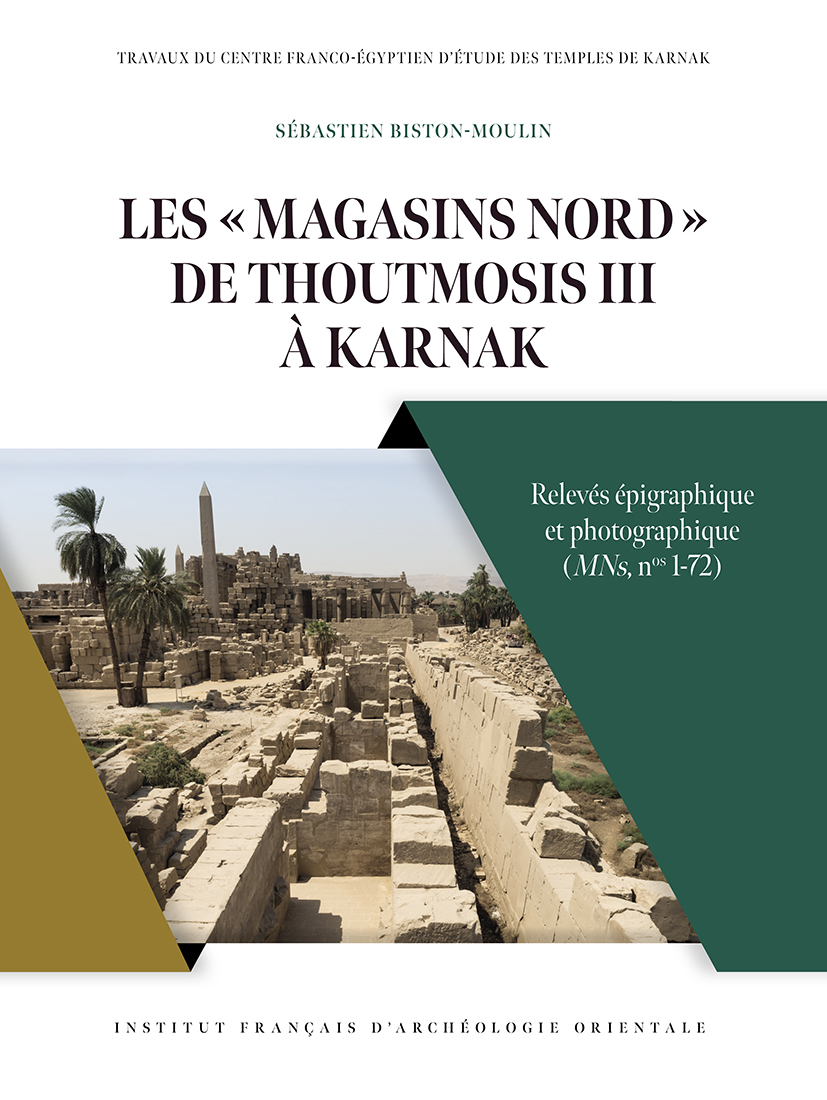
Sébastien Biston-Moulin
Les « Magasins nord » de Thoutmosis III à Karnak Relevés épigraphique et photographique (Mns, nos 1-71) BiGen 74; 370 p. Les « Magasins nord » de Thoutmosis III sont un ensemble de huit salles accessibles par le couloir périmétral de l’enceinte en grès du temple d’Amon-Rê à Karnak. Bâties par Thoutmosis III pendant son règne autonome après la disparition de la reine Hatchepsout, ces salles forment un complexe à l’accès restreint qui a subi plusieurs transformations architecturales dont les plus remarquables sont la modification de son accès ouest au cours du règne … [en savoir plus] 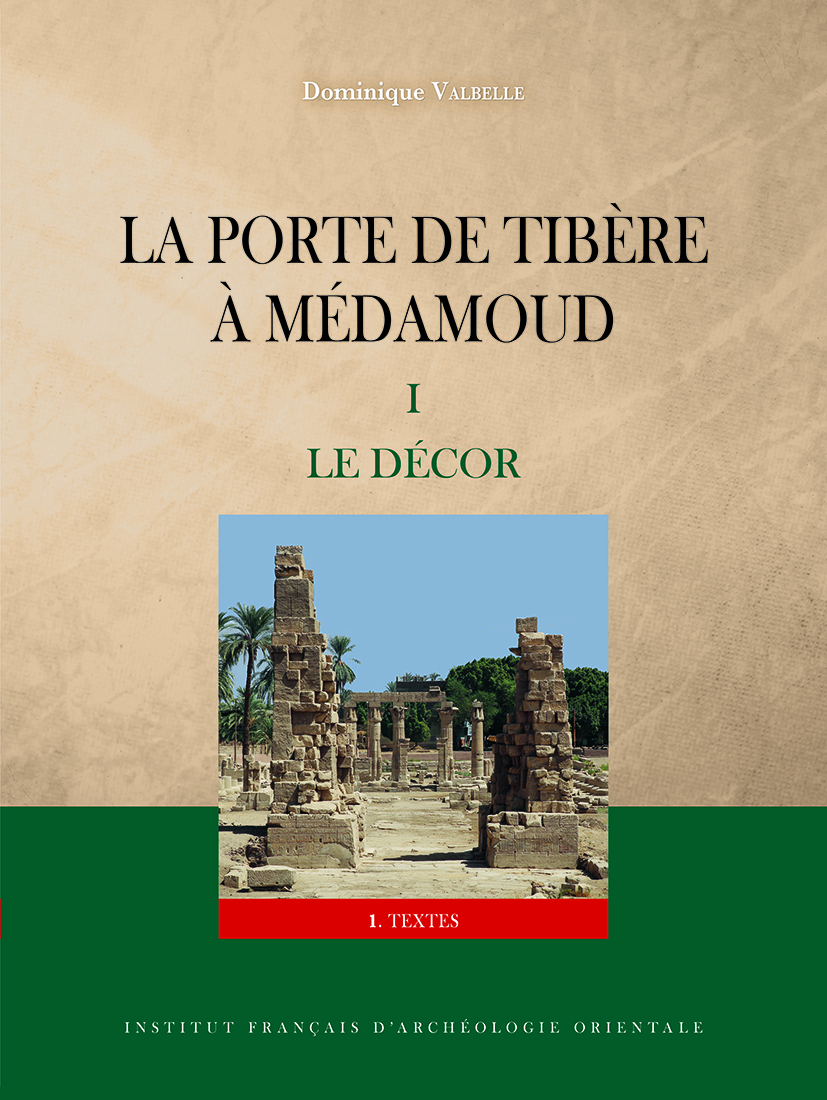
Dominique Valbelle
La porte de Tibère à Médamoud Volume 1 : Le décor (textes, planches, paléographie) MIFAO 151; 534 p. Un propylône introduit, dès le début du premier millénaire de notre ère, le complexe religieux de Médamoud, sur lequel s’appuie une enceinte datée d’Auguste par une stèle commémorative. Quoique l’édification de la porte ait été sans doute contemporaine de celle de l’enceinte et que le décor des embrasures ait été commencé sous ce règne, le monument est connu sous le nom de « Porte de Tibère », les scènes et inscriptions de la façade et du revers, ainsi que trois … [en savoir plus] 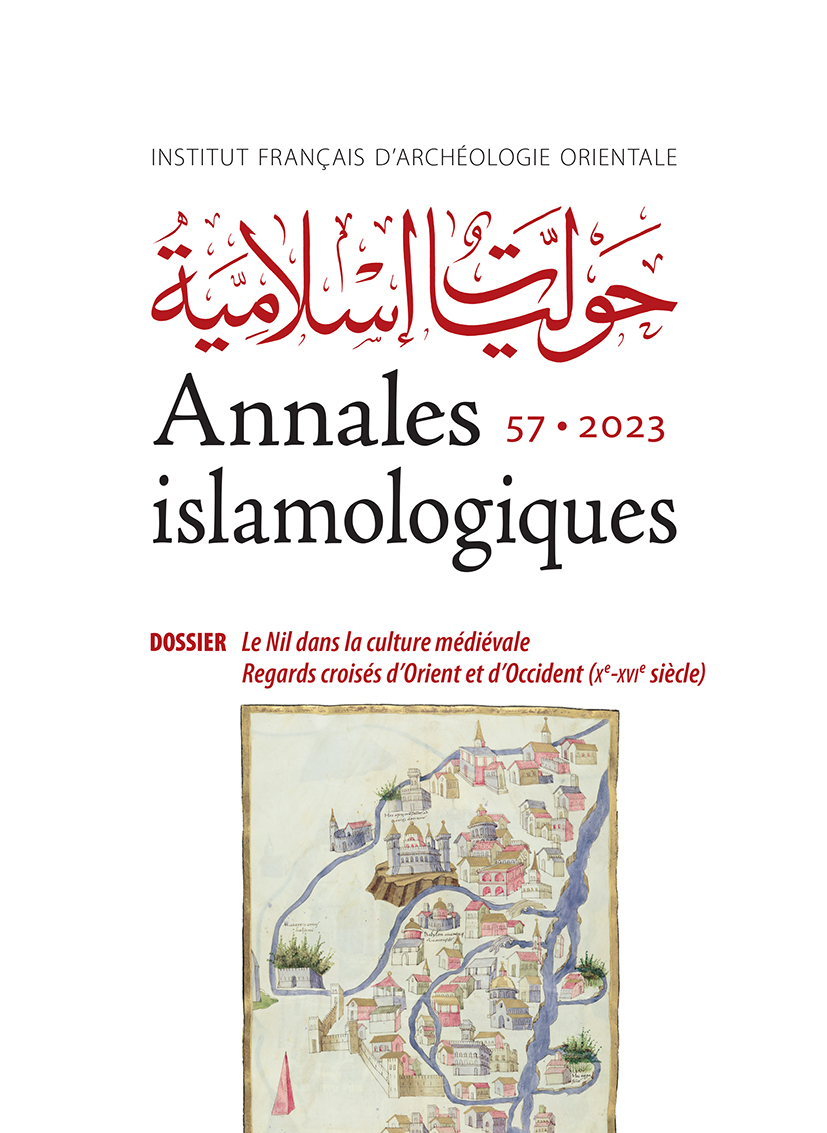
Annales islamologiques 57 Dossier : Le Nil dans la culture médiévale. Regards croisés d'Orient et d'Occident. Varia : six articles. AnIsl 57 Les Annales Islamologiques 57 proposent un dossier, coordonné par Robin Seignobos, sur les représentations du Nil et sa place en Orient et en Occident. En effet, parmi les fleuves du monde rares sont ceux qui ont suscité autant de curiosité et d’interrogations que le Nil. Ce constat vaut certes pour l’Antiquité mais ne se dément pas au Moyen Âge, non seulement en Égypte même et dans le reste du monde arabo-musulman mais aussi dans l’Occident latin où la fascination pour … [en savoir plus] 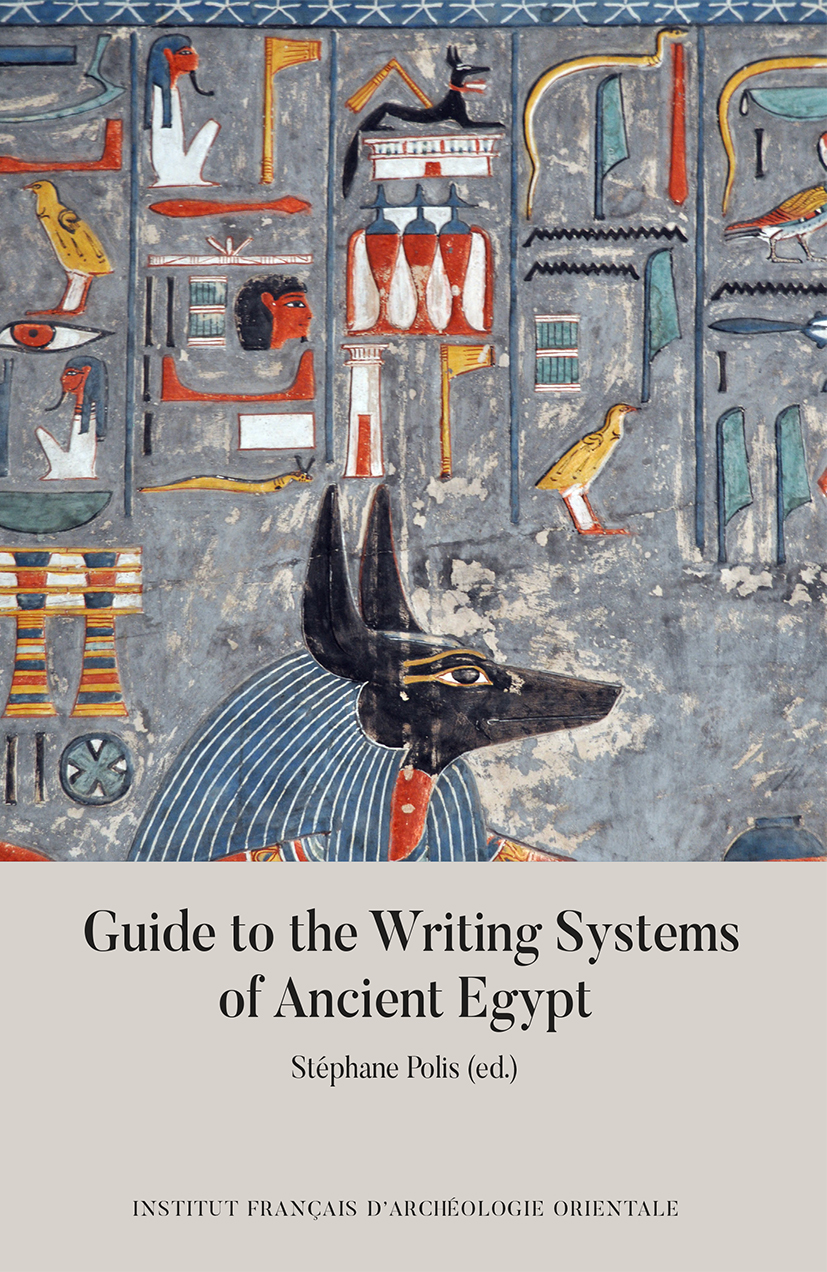
Stéphane Polis (éd.)
Guide to the Writing Systems of Ancient Egypt GIFAO 4; 360 p. Deux cents ans après le déchiffrement des hiéroglyphes par Jean-François Champollion, que sait-on des écritures de l’Égypte ancienne ? Ce Guide des écritures répond à la question, en exposant de manière accessible l’état de nos connaissances sur les différentes écritures qui furent utilisées sur la terre des pharaons. Le lecteur y découvrira plus de cinquante notices rédigées par des spécialistes, qui présentent la diversité de leurs manifestations dans le temps … [en savoir plus] 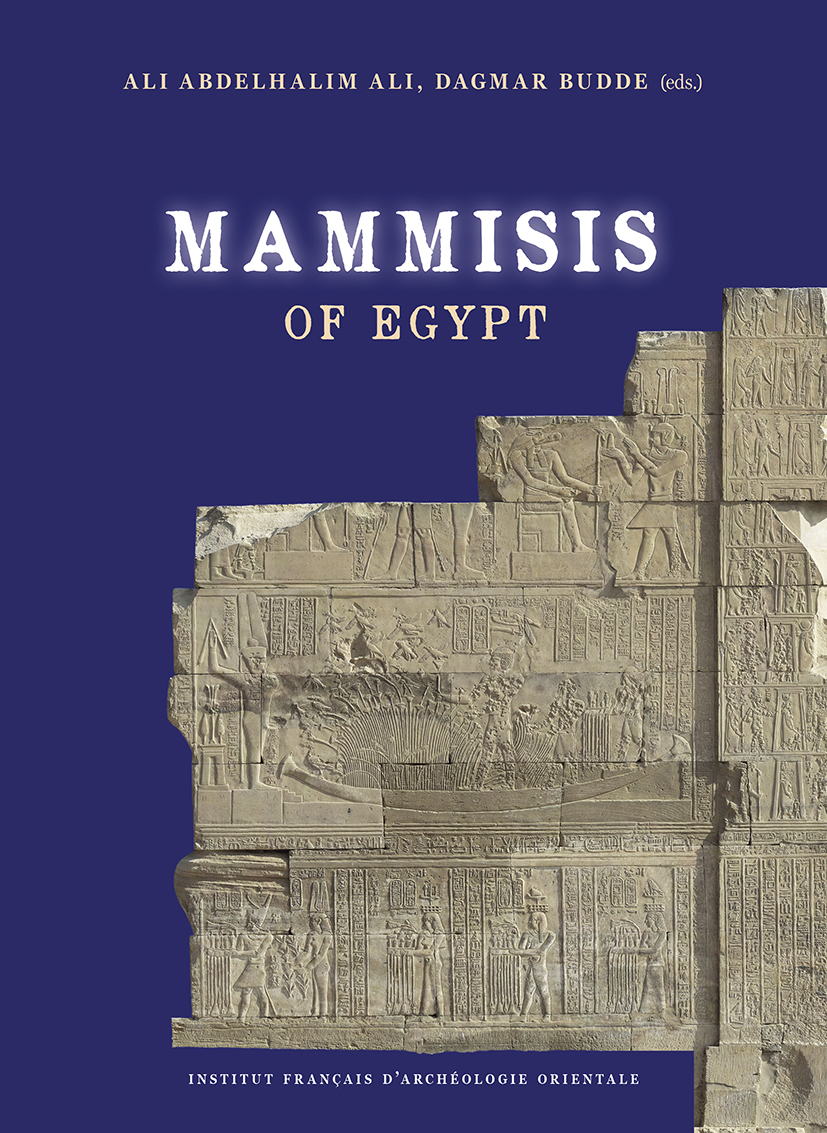
Ali Abdelhalim Ali (éd.), Dagmar Budde (éd.)
Mammisis of Egypt Proceedings of the First International Colloquium, held in Cairo, IFAO, 27-28 March 2019 BiEtud 185; 424 p. Les maisons de naissance (mammisis) sont des éléments importants des temples égyptiens de l’époque tardive, mais elles n’ont pas fait l’objet d’études détaillées depuis celle fondamentale de François Daumas, publiée en 1958. Depuis lors, des découvertes archéologiques et de nouvelles approches de la théologie et de la piété de l’Égypte gréco-romaine ont considérablement amélioré notre compréhension de ces bâtiments exceptionnels. Il est … [en savoir plus] 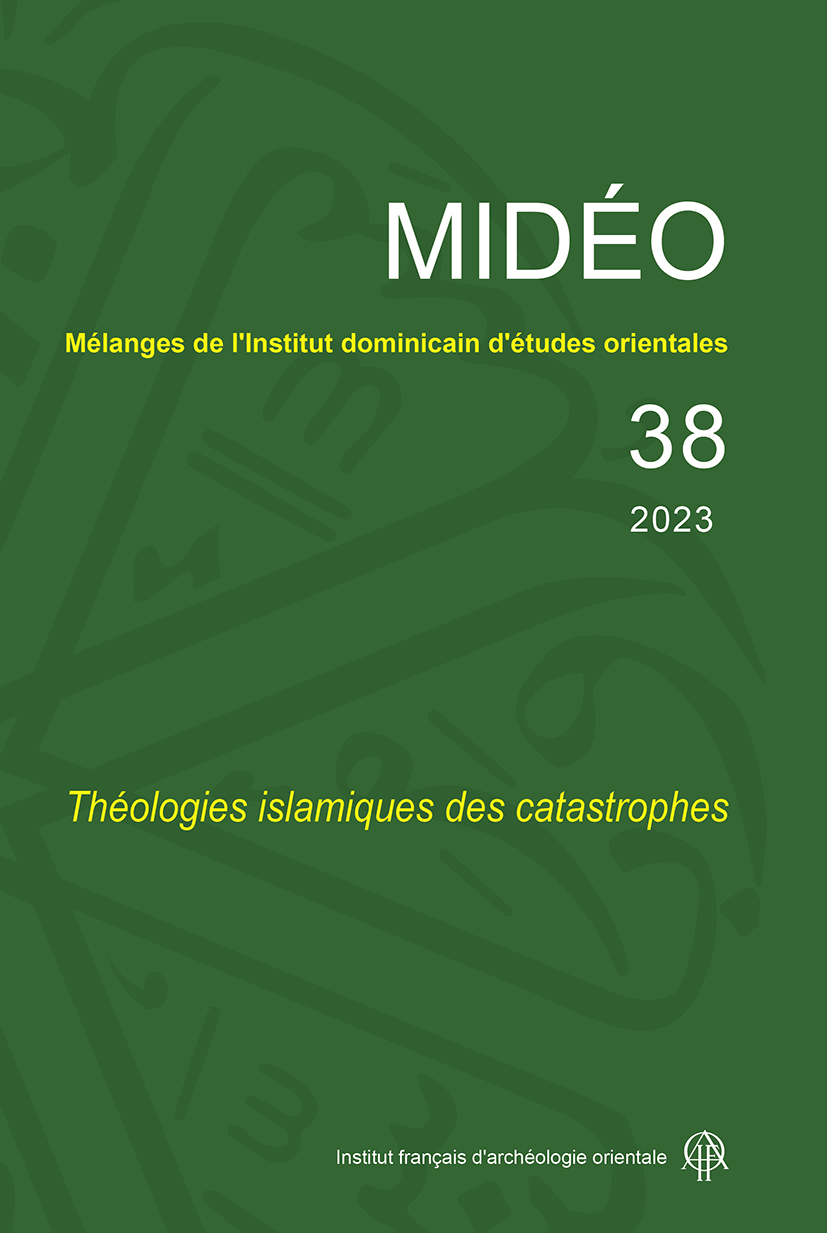
Dennis Halft (éd.)
Mélanges de l'Institut dominicain d'études orientales 38 Théologies islamiques des catastrophes MIDEO 38; 240 p. Ce numéro du MIDÉO dédié aux « Théologies islamiques des catastrophes », rappelle qu’à travers l’histoire, les sociétés musulmanes ont été régulièrement confrontées à des catastrophes diverses, naturelles ou humaines, et qu’elles ont trouvé des stratégies pour en expliquer les causes et effets. Les articles du dossier édité par Haoues Seniguer (Lyon) et Abdessamad Belhaj (Louvain), présentent des exemples de discours théologiques à travers les siècles, qui ont … [en savoir plus] 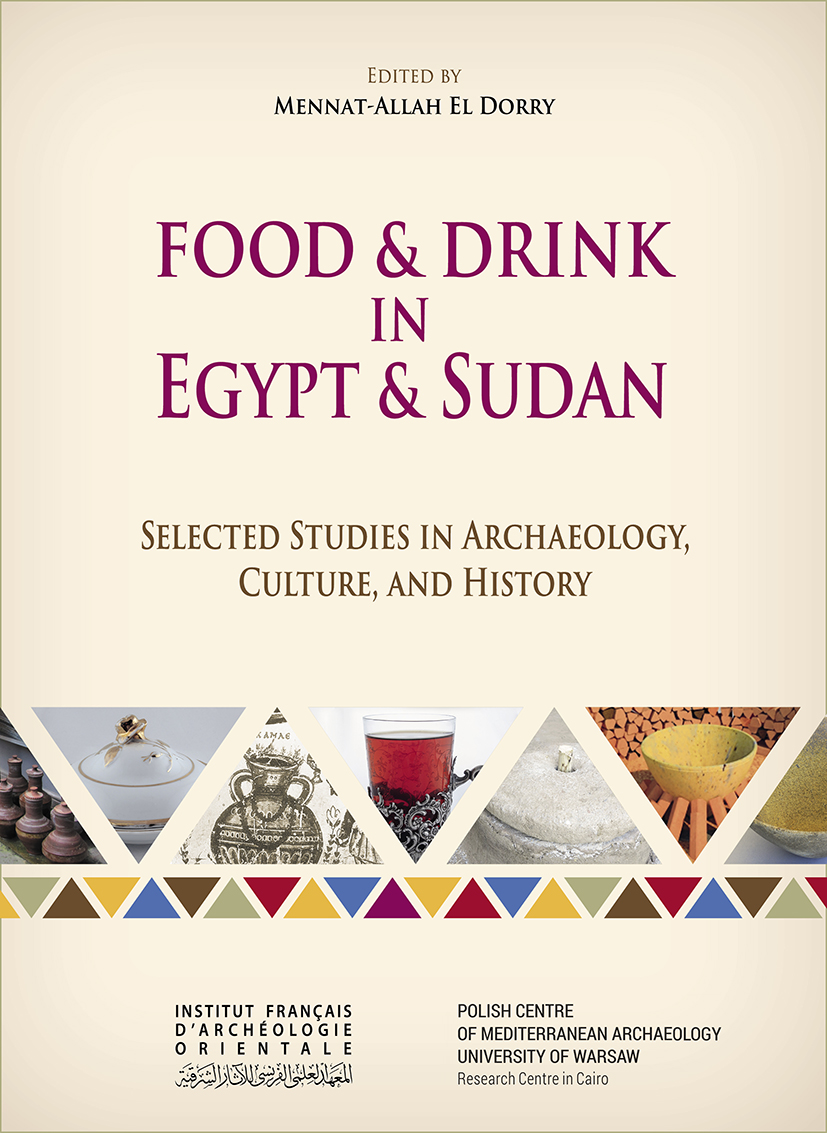
Mennat-Allah El Dorry (éd.)
Food and Drink in Egypt and Sudan Selected Studies in Archaeology, Culture, and History BiEtud 184; 328 p. L’étude des modes alimentaires historiques est aussi multiple et variée que la nourriture elle-même. Les changements que nous observons dans les habitudes et les choix alimentaires au fil du temps révèlent l’évolution des climats sociaux et politiques et nous aident à imaginer la vie quotidienne et l’au-delà de nos ancêtres. La nourriture jouait certainement un rôle dans les rites funéraires ; elle était offerte aux défunts, bien sûr, mais aussi … [en savoir plus] 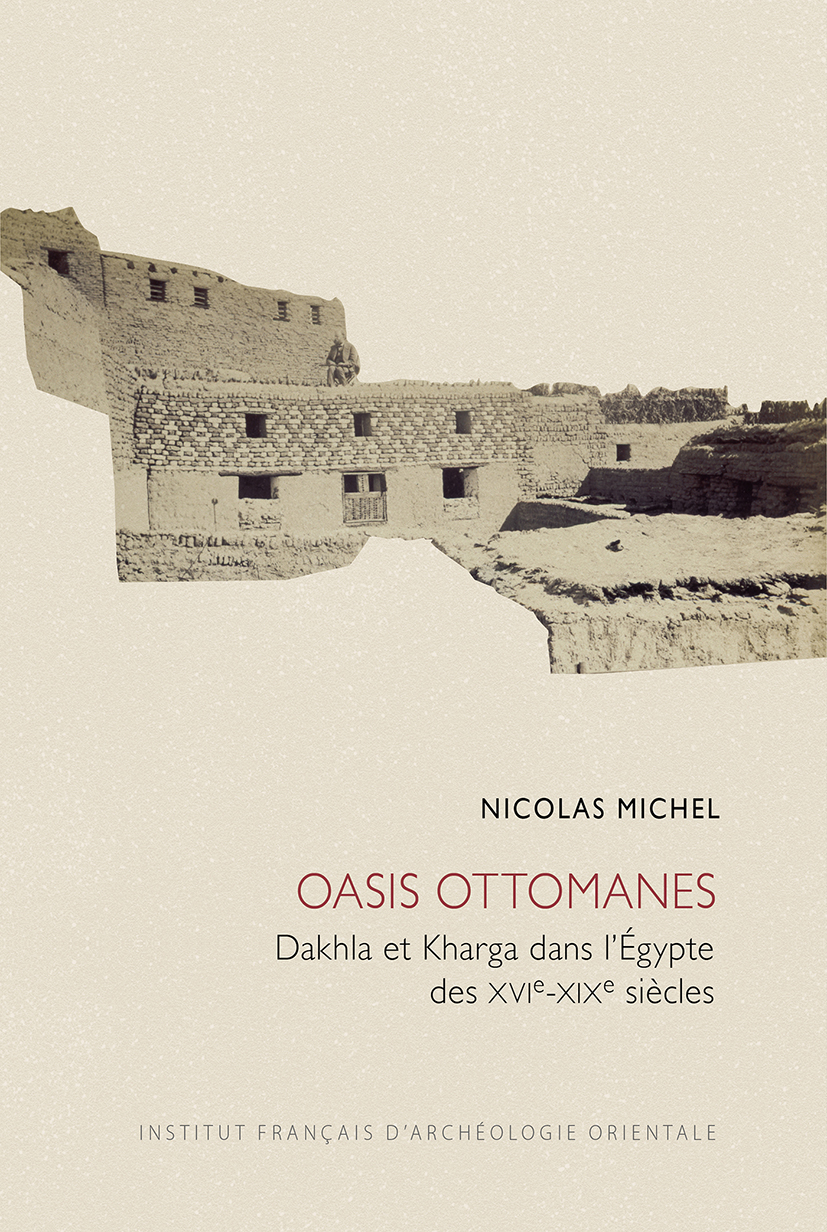
Nicolas Michel
Oasis ottomanes Dakhla et Kharga dans l’Égypte des XVIe-XIXe siècles CAI 36; 248 p. Ce livre explore la place des oasis de Dakhla et Kharga dans l’Égypte et l’empire ottomans. Il entend contribuer à la réflexion sur les caractéristiques et les limites de la notion d’ottomanité, vue par les habitants de cette région qui, du Caire, paraissait lointaine et isolée. Il s’appuie sur plusieurs ensembles d’archives privées, en grande partie inédits, complétés par les récits de voyageurs et la documentation de l’époque contemporaine. En dépit de leur … [en savoir plus] 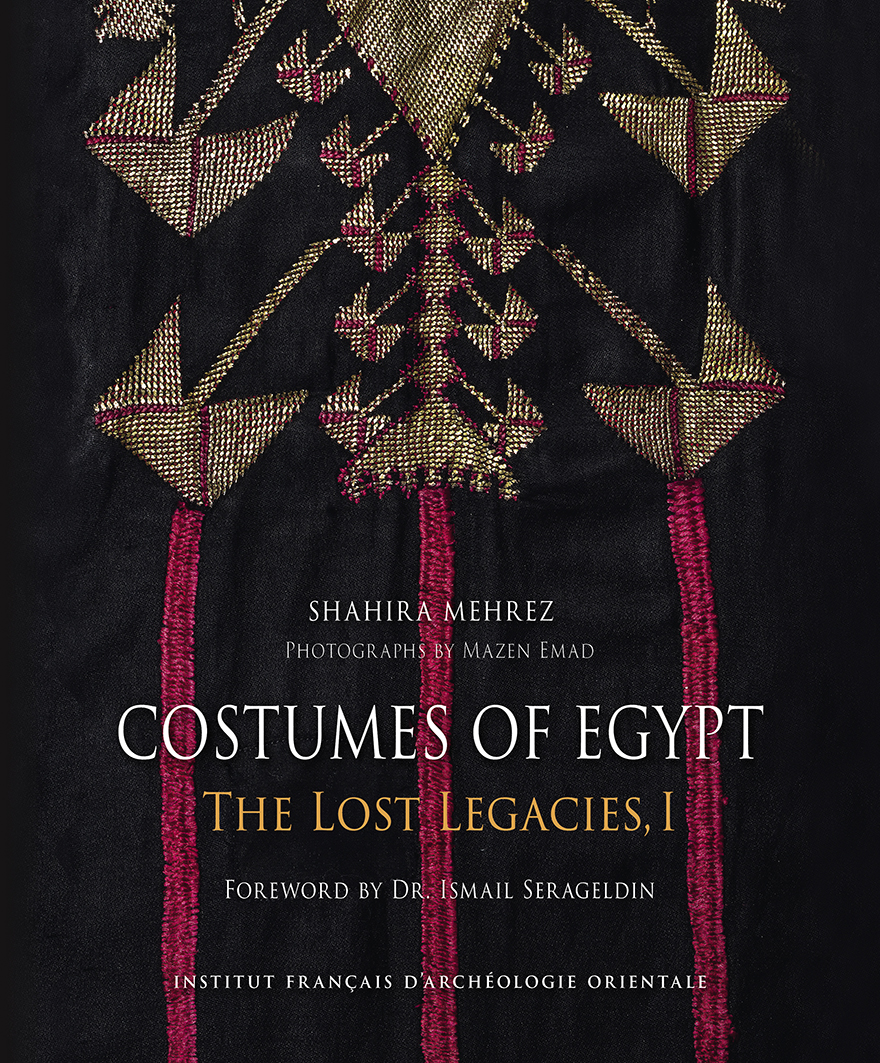
Shahira Mehrez
Costumes of Egypt. The Lost Legacies. I. Dresses of the Nile Valley and its Oases BiGen 68; 406 p. Costumes of Egypt, The Lost Legacies résume des décennies de recherche par Shahira Mehrez : il s'agit d’un ouvrage en quatre volumes qui recense et retrace l’origine de modes vestimentaires et de bijoux égyptiens jusqu’ici non documentés, dont la plupart sont aujourd’hui tombés en désuétude. Les costumes étudiés dans ce premier volume établissent qu’au-delà des situations géographiques éloignées, au-delà des diversités religieuses et ethniques, à travers des … [en savoir plus] 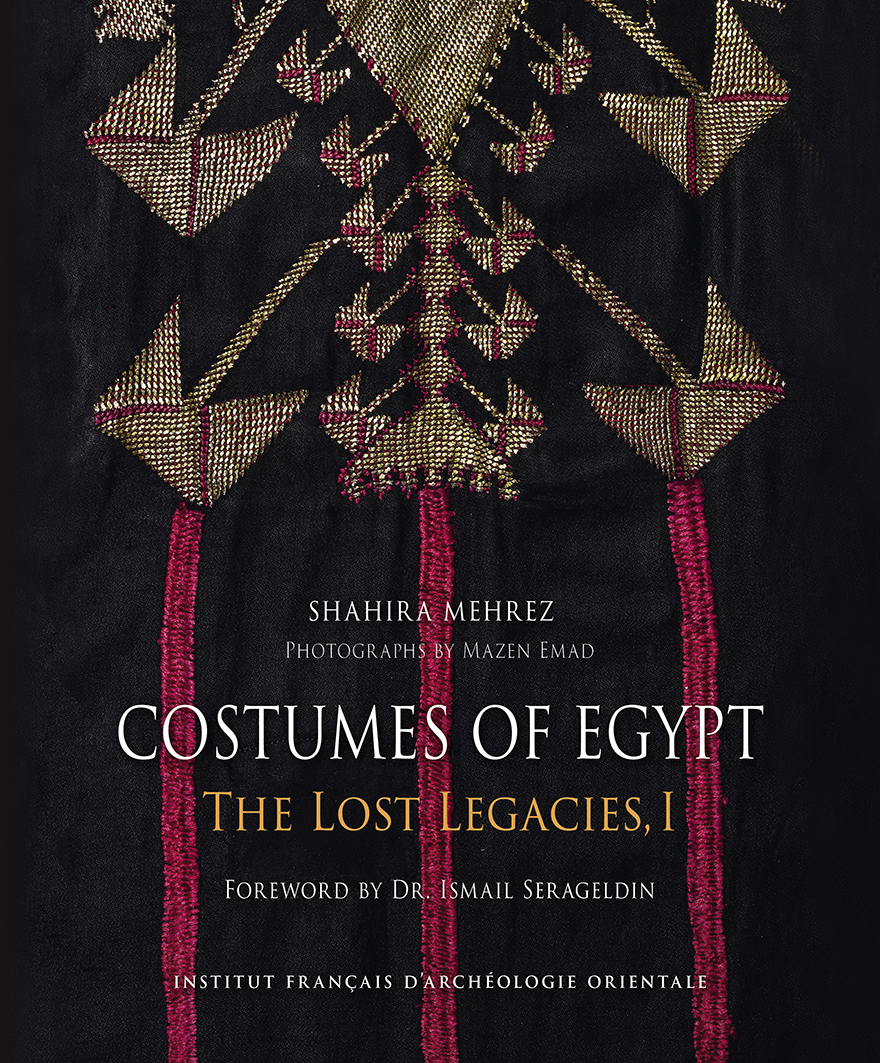
Shahira Mehrez
Costumes of Egypt. The Lost Legacies. (Limited Edition) I. Dresses of the Nile Valley and its Oases BiGen 68.5; 406 p. Édition limitée Costumes of Egypt, The Lost Legacies résume des décennies de recherche par Shahira Mehrez : il s'agit d’un ouvrage en quatre volumes qui recense et retrace l’origine de modes vestimentaires et de bijoux égyptiens jusqu’ici non documentés, dont la plupart sont aujourd’hui tombés en désuétude. Les costumes étudiés dans ce premier volume établissent qu’au-delà des situations géographiques éloignées, au-delà des diversités … [en savoir plus] 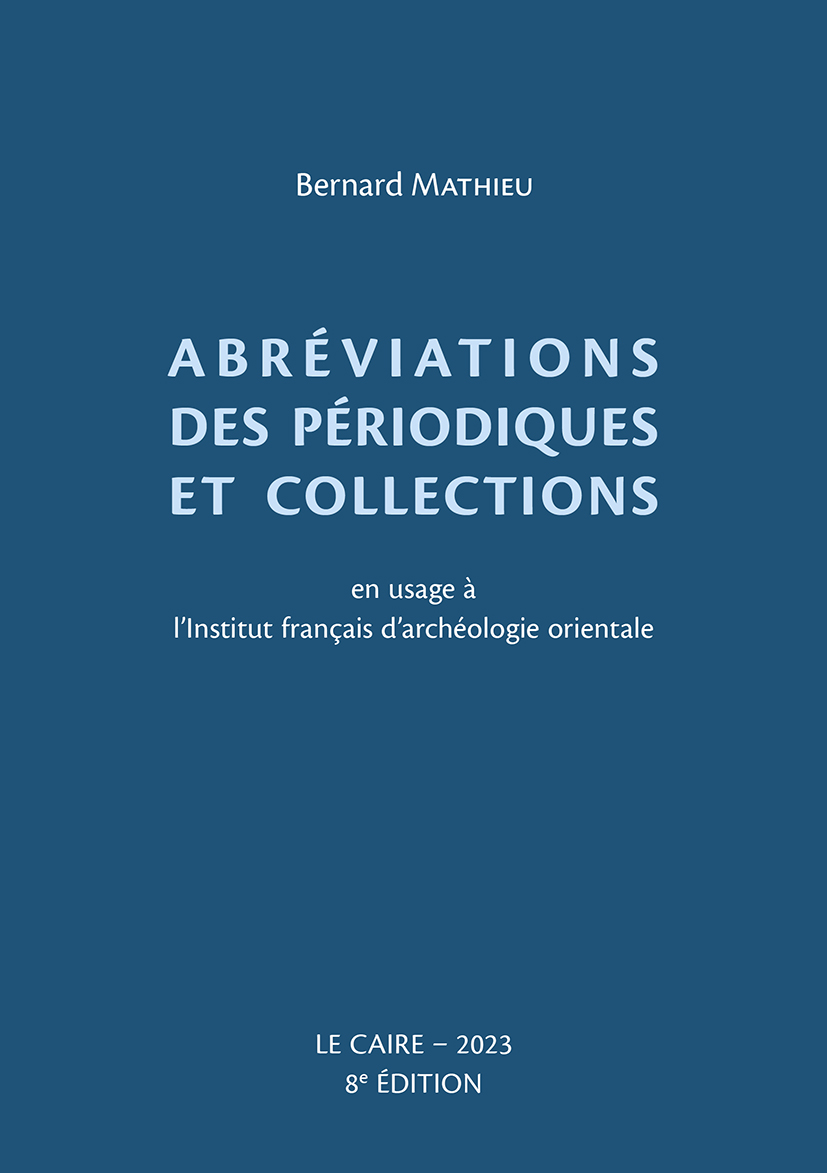
Bernard Mathieu
Abréviations des périodiques et collections en usage à l'Ifao, 8e éd. Divers 9 La liste de périodiques, collections et usuels collectés par Bernard Mathieu concerne les différents domaines de recherche représentés dans les publications de l’Institut français d’archéologie orientale du Caire, à savoir l’égyptologie, l’Antiquité classique, l’Orient ancien, les études bibliques, byzantines, coptes, arabes et islamologiques. Retenant essentiellement les périodiques de diffusion internationale, cette liste a été mise à jour à l'occasion de cette 8e … [en savoir plus] 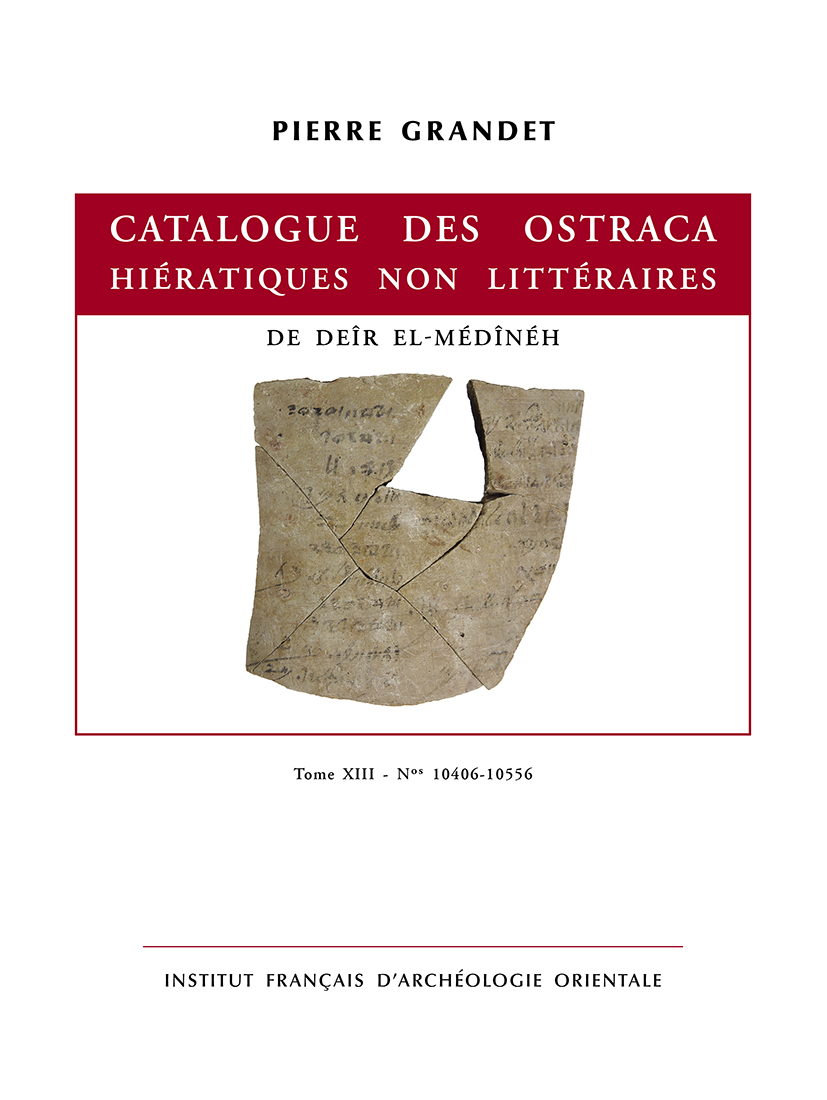
Pierre Grandet
Catalogue des ostraca hiératiques non littéraires de Deîr el-Médînéh Tome XIII - Nos 10406-10556 DFIFAO 53; 522 p. Cette treizième livraison du Catalogue des ostraca hiératiques non littéraires de Deîr el-Médînéh comprend la publication (en photographie et fac-similé), la transcription et la traduction commentée de 151 ostraca. Cet ensemble est composé de documents appartenant aux différentes catégories représentées dans les précédents volumes du catalogue. Parmi les documents institutionnels, on rencontre ainsi des listes d’ouvriers, des documents … [en savoir plus] 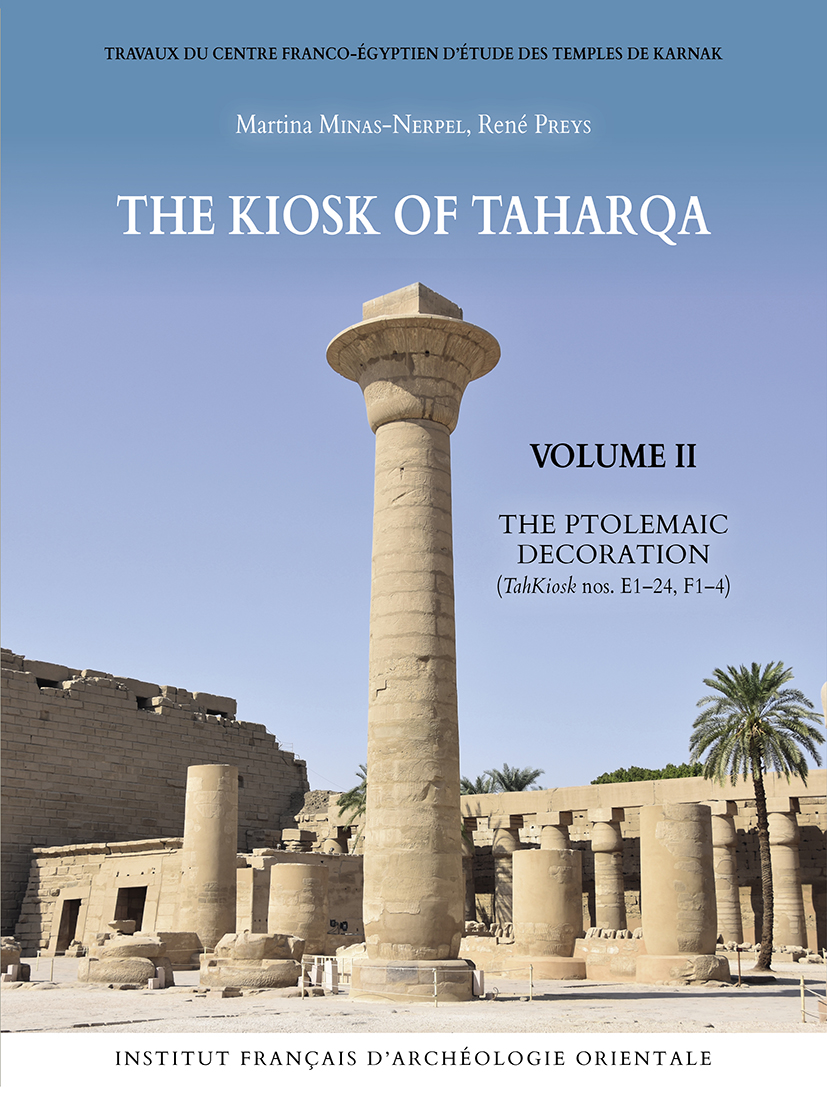
Martina Minas-Nerpel, René Preys
The Kiosk of Taharqa Volume II The Ptolemaic Decoration BiGen 72; 252 p. From the reign of Ptolemy IV Philopator (221–204 BC), an extensive building and decoration programme is attested throughout Egypt, with a specific emphasis on the cult of Osiris and the child gods. The royal legitimation, in which Horus of Edfu and Amun of Thebes played a major role, was a further focal point. With the Theban revolt (206–186 BC), the royal support of the Egyptian temples stopped abruptly and was only resumed under Ptolemy VI Philometor. In the temple of Amun-Ra at Karnak, the … [en savoir plus] 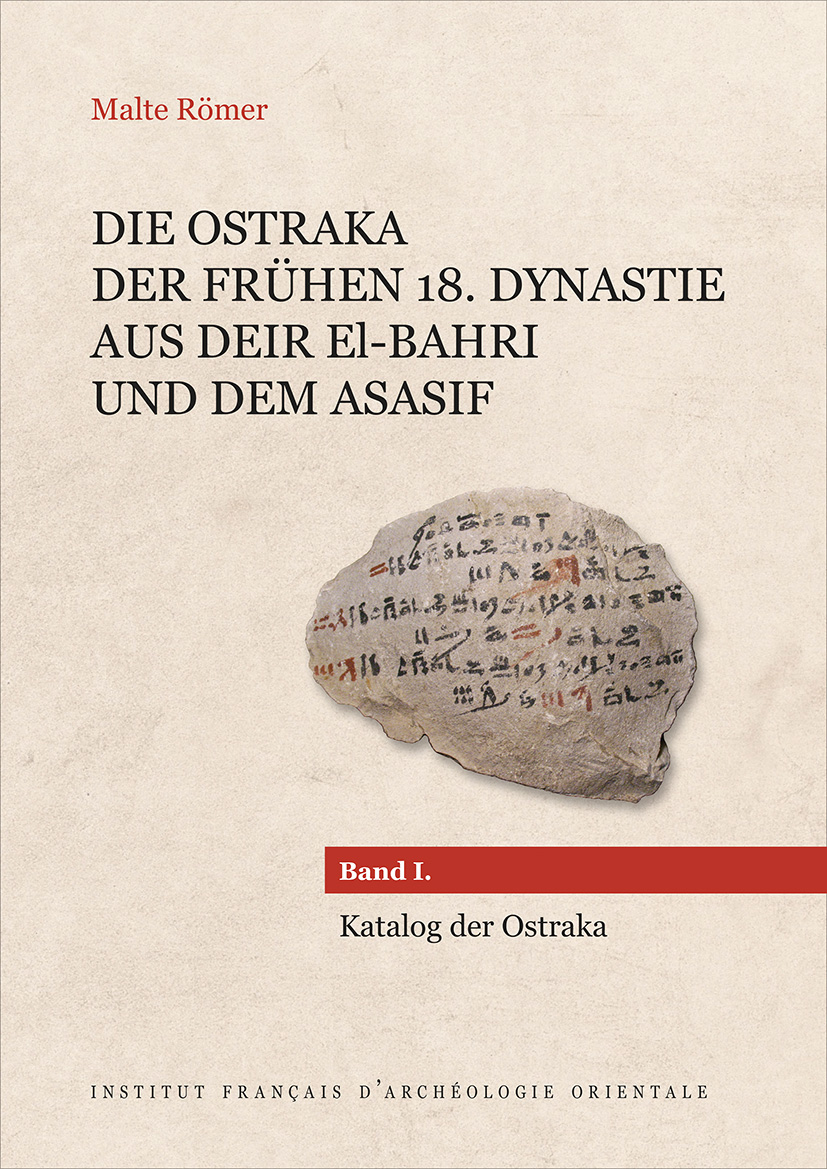
Malte Römer
Die Ostraka der frühen 18. Dynastie aus Deir el-Bahri und dem Asasif I. Katalog der Ostraka / II. Auswertung, Verzeichnisse, Paläographie / III. Tafeln BiGen 73; 1673 p. Cette publication contient une grande partie des ostraca qui ont été réalisés lors des travaux de construction des temples du début de la XVIIIe dynastie à Deir el-Bahari. Ces ostraca, dont le nombre est supérieur à 700, sont restés largement inédits plus d’un siècle après leur découverte. 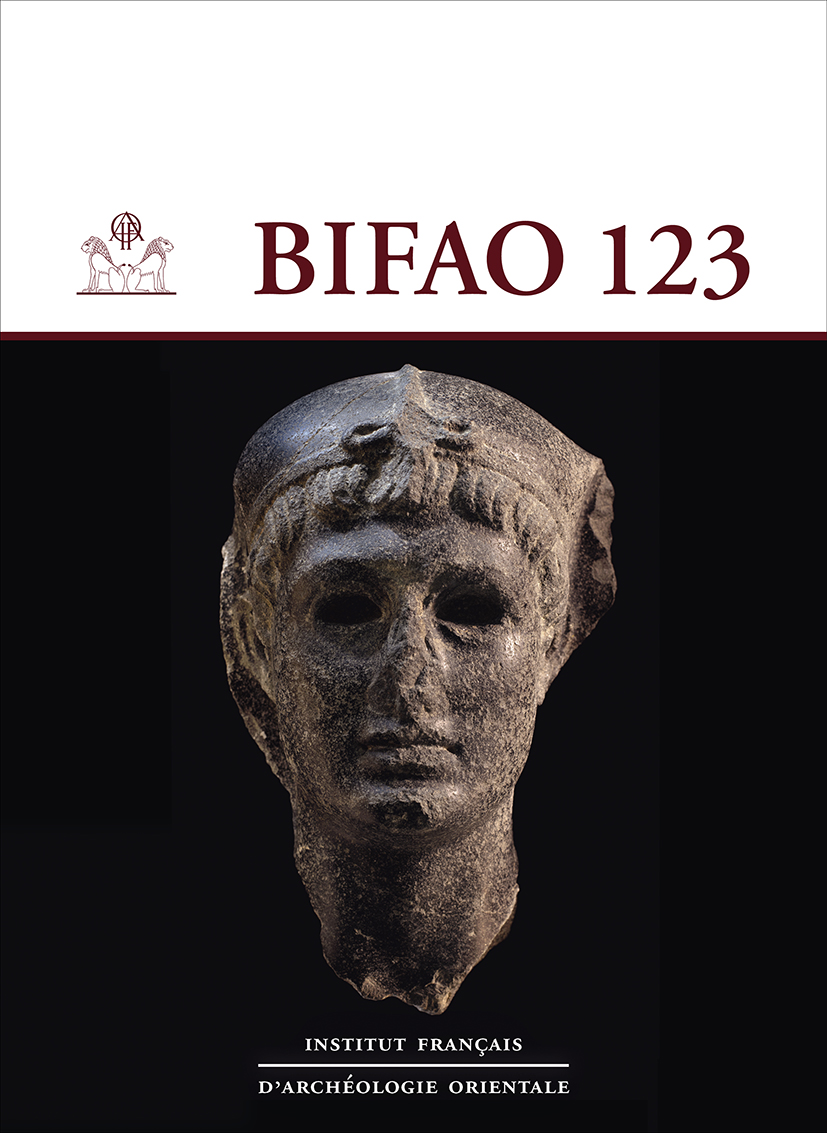
BIFAO 123 BIFAO 123; 616 p. Le Bulletin de l’Institut français d’archéologie orientale (BIFAO) couvre l’ensemble des champs de l’égyptologie depuis sa première publication en 1901. Les études qui y paraissent, dont l’aire chronologique s’étend de l’Égypte prédynastique jusqu’à l’époque byzantine, illustrent l’état des recherches actuelles dans les domaines de l’archéologie, l’épigraphie, la lexicographie, l’histoire de l'art, la religion et la philologie. en savoir plus] |

IFAO Newsletter
January 2024
Sections: (-) Headlines (-) Some questions for Pascal Ménoret (-) IFAO notebook (-) Scientific Events (-) Scientific Meetings (-) On the Ifao YouTube channel (-) Publications

◼︎ Photo of Ifao staff, January 2024 © A. Bahgat/Ifao.
Headlines
|
The last few months of 2023 have been exceptionally dynamic. The staff has been renewed and expanded, particularly the management team. Pierre Tallet succeeded Laurent Coulon as director of Ifao on September 1. General Secretary Catherine Lion-Josserand left the institute in December after seven years of tireless commitment; she was succeeded by Yann Hervo. Pierre Tallet's arrival at the Ifao in June as the new director of the institute is in line with the continuity of his career. In many ways, it's a homecoming for an Egyptologist who, since his first venture into Egypt in the early 1990s, has forged a special relationship with the country. Formerly head of publications at the Ifao (DATES), Pierre Tallet played a major role in its development, particularly through his work in the Red Sea. A world-renowned Egyptologist, he holds the Chair of Egyptology at Sorbonne University, and is a scientific correspondent of the Académie des Inscriptions et Belles-Lettres. He also directed the UMR 8167 Orient et Méditerranée from 2019 till 2023. The palace was also enriched by the strengthening of long-standing ties between the Institute and the French Section of Sudanese Antiquities (SFDAS). The SFDAS director, Séverine Marchi, and her colleague, Faiza Drici, have been hosted here since December, due to the war in Sudan. |
|
◼︎ Yann Hervo, succeded Catherine Lion-Josserand as general secretary in November 2023. |
|
The end of the year was also marked by a high level of scientific activity. Thirteen archaeological missions took place between September and December 2023. A new seminar, organized jointly with the DAIK (Deutsches Archäologisches Institut Kairo), was launched in September: "Exploring Egypt Seminar: Histories and Historiographies"; it invites researchers to reflect on the ways in which knowledge was constructed in Egypt, from the 19th century to the present day. The seminar, which is both multidisciplinary and cross-disciplinary, is led by Fatma Keshk, postdoctoral Egyptologist, and Malak Labib, historian of contemporary Egypt and scientific member of Ifao. The same multi-disciplinary, cross-disciplinary approach was used at Ifao for the symposium "Reading reuse. Image recycling in Egypt and beyond", organized by two Egyptologists, Axelle Brémont and Simon Connor, and Vera Elizabeth Allen, from Basel University. For four days, from October 30 to November 2, the researchers were able to work, in the presence of a large audience, on the topic of the re-use of images in art. In parallel and in dialogue with the symposium, an exhibition was held in the main hall of the institute, featuring the work of ten artists living in Cairo. At the same time, 'Costumes of Egypt. The lost legacies' , was published, and author Shahira Mehrez launched it at the National Museum of Civilization (NMEC) on October 23, and at the Ifao on November 6. Once again, a large audience gathered in the palace to discover this long-awaited work, which is already proving to be an outstanding success.
◼︎ Ghozza village excavations, Eastern Desert archaeological mission, January 2024 (© A. Bahgat/Ifao) |
◼︎ Launch of 'Costumes of Egypt' by Shahira Mehrez with two public lectures at Ifao and NEMEC.
◼︎ 2nd session of the Exploring Egypt seminar in cooperation with DAIK, by Dina Bakhoum at Ifao on December 3. |
Some questions for Pierre Grandet..
|
An Egyptologist specialising in the New Kingdom and hieratic texts, Pierre Grandet has been in charge of publishing the Ifao's collection of ostraca since 1997. |
||
|
◼︎ Pierre Grandet |
||
1. Pierre Grandet and the ostraca of the Ifao: a long-standing connection... How did it begin?I first came to the Ifao in the mid-1980s on a post-doctoral fellowship from the Ministry of Foreign Affairs, mainly to use the library and finalise the publication of my thesis. At the time, the rooms of the missionaries were where the archive offices are today. After several unsuccessful applications to become a resident at the Ifao, I was finally taken on by the Khéops Fund for Archaeology as a lecturer. I spent most of my career there. I was then able to teach at several universities: Angers, Poitier and Lille, and so I was able to continue my research, ultimately with much more freedom than I would have had in a university setting. My relationship with the Ifao's ostraca began in 1997 when Nicolas Grimal, then director of the Ifao then, put me in charge of publishing the collection. I had in fact been introduced to him by Yvan Koenig, professor of hieratics at the EPHE, who, wanting to devote himself to papyri and knowing my interests, had recommended me. I've been coming every year since, with the exception of the 2011 revolution and in 2020 because of the Covid pandemic. 2. Who are the most important people you have worked with over the years?The list would be long, but let me say that I've been lucky enough to have always enjoyed the best working conditions at the Ifao in general, with the help of colleugues of the archive department, photography department and the edition. But if I have to mention anyone, it's Nicolas Grimal: when I asked for major work to be done to reorganise the ostraca collections room to make it easier to access and study, he immediately approved the project, even going beyond my expectations by buying equipment, such as an electric hoist, which I hadn't dared to ask for. He really gave us the best means to work. |
||
3. The ostraca collections have had several lives at the Ifao. Can you tell us about them?Indeed, because of their weight and volume, they have always been a constant concern and an object of reflection. Several architectural projects were considered to relocate the collections, which were weighing down the building and preventing the library from being expanded. Several projects were considered, but never came to fruition. It was not until 2011 that Nadine Charpion, then head of the archives department, took on the task of relocating the ostraca by devoting a room within the department to them. Unfortunately, the solution was called into question because the ostraca threatened the solidity of the room's floor. In the end, the collections were definitively moved to Room 5 and to the Ostracothèque on the mezzanine above the administration corridor. Part of the Palais with a concrete floor. 4. You have published 6 volumes on collections and are currently working on the seventh. It's been said that Pierre Grandet changed the way ostraca were published. How true is this?I have continued the work of publishing the series of Catalogues of the non-literary Hieratic Ostraca of Deir El Médineh begun by Černý then Sounron and whose first volume appeared in 1939. Volume 8 was the first volume I edited. After that, I published six more. The seventh is currently being published (it will be volume 14 of this series). At my age, I don't expect to be able to complete the publication of the entire Ifao collection, which is quite substantial. I will no doubt pass on the torch. In the discipline, the tradition was to publish ostraca without any translation nor interpretation so as not to influence other researchers, but I decided to accompany my publications with comments and interpretations, inspired from other disciplines. Indeed, following my discussions with Jean luc Fournet and Hélène Cuvigny, I drew a great deal of inspiration from their way of publishing Greek ostraca. 5. What do you think the future holds for these collections?In my opinion, there is a conflict between conservation and research: the priority of conservation is to catalogue and store as many objects as possible, isolating them in individual envelopes in a small amount of space, whereas, for research purposes, it would be preferable to be able to put together groups of objects so that they can be linked together more easily. But this is proving more difficult, given the current way of storing them. I've always dreamt of building a small building on the ground, in the garden for example, so that the ostraca would no longer be seen as a threat to the structure of the building. |
◼︎ From bottom to top: Pierre Grandet in the Ostraca room in 2010 and the same room today, now part of the library. |
|
Ifao notebook
ArrivalsTwo scientific members have joined the Ifao: - Laura Aguer, Hellenistic papyrologist. - Anna Lagaron, Arabic epigraphist. The following researchers have joined the Ifao: - Cristinà Alù, Egyptologist, awarded the Ifao/PCMA postdoctoral fellowship. - Mohamed Ibrahim, medievalist, Assistant Professor at Ayn Shams University, is now an Ifao Associate Researcher. - Amany El-Naggar, ceramologist, doctoral student at Aïn Shams University, is the winner of the Ifao doctoral scholarship. The following agents have joined Ifao: - Yann Hervo has been appointed General Secretary in November. - Florence Albert, a former Ifao scientific member, is now Assistant to the Head of the Editorial Department, in charge of operational management. - Yassine Temlali has joined Ifao as editor (Arab Studies). - Sarah Heiba has been recruited as Scientific Management Assistant. -Khaled Ali, bookbinder, and Mohamed Mohamed Hussein, bookbinder, have joined the Press team. Departures- Catherine Lion, General Secretary, left the Ifao in November 2023. - Sabah Fawzy, has left the Ifao press. |
◼︎ Laura Aguer |
◼︎ Anna Lagaron |
|
◼︎ Cristinà Alù |
◼︎ Yassine Temlali |
|
|
◼︎ Mohamed Ibrahim |
|
|
|
◼︎ Mohamed Hussein |
◼︎ Khaled Ali |
|
|
◼︎ Sarah Heiba |
◼︎ Florence Albert. |
Scientific events
 |
Les conférences de l'Ifao lectures Series |
|
|
|
|
Ifao research seminar |
|
|
|
|
Lecture series: Egyptology Bi-L-ʿarabīOrganised in partnership with "Al-Makân wa-l-Nâs" |
|
|
|
 |
Seminar : "Qira'at"- Reading historical documents from Egypt, Medieval till modern times (سلسلة ندوات قراءآت )Organisé par Prof. Magdi Guirguis |
|
|
|
|
Seminar 'Conversations about Nomadism' |
|
|
|
|
Exploring Egypt Seminar: Histories and HistoriographiesEn partenariat avec DAIK |
|
|
 |
Les rendez-vous de l'archéologie lectures SeriesEn partenariat avec l’IFE |
|
|
|
|
Overview of Current Research in the Eastern Mediterranean During the First and Second Millennia BC MouniraEn partenariat avec IFEA, IFPO & EFA |
|
|
|
|
Book Launch |
|
|
Formations
 |
On September 30th 2023, Training by Mathilde Prevost & Bassem Gihad: Akhet Seminar on current developments and methods in Ancient Egyptian history and archaeology, in partnership with Central Traning Unit - MoTA [more] |
|
 |
From 1st to October 5th 2023, IFAO Academies for Young Researchers by Florence Albert, Annie Gasse et Nathalie Sojic: 7e Académie Hiératique, in partnership with ENiM, UMR 5140 – ASM, Université Montpellier 3 [more] |
|
 |
From 8th to October 12th 2023, Training by Sylvie Marchand (IFAO) & Yahya Elshahat (université du Fayoum): Atelier d’écriture. Publier de la céramique., in partnership with université du Fayoum [more] |
|
 |
On October 15th 2023, Training by Hassan Sélim & Pierre Tallet: Scientific examination for Egyptian artefacts: Genuine or Fake ?, in partnership with Faculty of Archaeology, Aïn Sham University [more] |
|
  |
On November 14th 2023, Les cours de l’Ifao by : Arts de vivre en Égypte ancienne [more] |
|
 |
On November 23rd 2023, Training by Pr. Ayman Fouad Sayed: دورة تدريبية في علم المخطوطات والنشر النقدي للنصوص ( نوفمبر- ديسمبر ٢٠٢٣) [more] |
|
 |
From 18th to December 19th 2023, Training by Naglaa Hamdi Boutros & Ahmed ELnemr: كيف تكتب وتنشر بحثًا في الآثار الإسلامية والقبطية, in partnership with MoTA (bureau scientifique) & Musée d'art islamique du Caire [more] |
Exposition
 |
From October 30th to November 16th 2023, Exhibition by Vera Elizabeth Allen, Axelle Brémont & Simon Connor: REading REuse [more] |
Exceptional events
 |
On October 11th 2023, Screening of a documentary by Petr Horký & Miroslav Bárta: Civilization. A good news about the end of the world. [more] |
Scientific meetings
 |
From October 30th to November 2nd 2023, International conference organized by Vera Elizabeth Allen, Axelle Brémont & Simon Connor: Reading reuse. Image recycling in Egypt and beyond [more] | |
|
|
From 28th to September 30th 2023, Seminar organized by : Séminaire des Écoles françaises à l’étranger 2023 [more] |
On the Ifao Youtube channel
Publications

Sébastien Biston-Moulin
Les « Magasins nord » de Thoutmosis III à Karnak Relevés épigraphique et photographique (Mns, nos 1-71) BiGen 74; 370 p. The “Northern Storerooms” of Thutmosis III are a set of eight chambers accessible through the corridor within the sandstone enclosure of the Temple of Amun-Re at Karnak. Built by Thutmosis III during his autonomous reign after the death of Queen Hatshepsut, these chambers form a complex with restricted access that underwent several architectural transformations. Among the most remarkable are the modification of its western entrance during Thutmosis III’s own reign … [more] 
Dominique Valbelle
La porte de Tibère à Médamoud Volume 1 : Le décor (textes, planches, paléographie) MIFAO 151; 534 p. A propylon introduces, from the beginning of the first millennium AD, the religious complex of Medamud, on which is based an enclosure dated to Augustus by a commemorative stele. Although the construction of the gate was probably contemporary with that of the enclosure and the decoration of the embrasures began during this reign, the monument is known as the "Gate of Tiberius", as the scenes and inscriptions on the façade and on the reverse side, as well as three scenes in the northeast … [more] 
Annales islamologiques 57 Dossier : Le Nil dans la culture médiévale. Regards croisés d'Orient et d'Occident. Varia : six articles. AnIsl 57 Few of the world’s rivers have aroused as much curiosity and questioning as the Nile river. This was certainly true in antiquity, but it was also true in the Middle Ages, not only in Egypt itself and the rest of the Arab-Muslim world, but also in the Latin Western world, where fascination with the Nile was no less intense. A biblical river said to have originated in paradise, a marvel of nature whose annual floods defy the order of the seasons, the Nile is both the object of admiration and of … [more] 
Stéphane Polis (éd.)
Guide to the Writing Systems of Ancient Egypt GIFAO 4; 360 p. What do we know about the writings of ancient Egypt, two hundred years after Jean-François Champollion deciphered hieroglyphs? This Guide answers the question in an easily accessible format, presenting the current state of knowledge on the different scripts that were used in the Land of Pharaohs. The reader will find over fifty articles written by specialists, presenting the diversity of scripts in time and space, explaining their main organizational principles, and describing the main contexts … [more] 
Ali Abdelhalim Ali (éd.), Dagmar Budde (éd.)
Mammisis of Egypt Proceedings of the First International Colloquium, held in Cairo, IFAO, 27-28 March 2019 BiEtud 185; 424 p. Birth Houses (Mammisis) are important components of late Egyptian temple complexes but have not been investigated in detail since the fundamental study of François Daumas published in 1958. In the meantime, new archaeological findings as well as re-evaluations of theology and piety in Greco-Roman Egypt have considerably expanded our traditional understanding of these extraordinary buildings. Therefore, reassessment of phenomena and expanded research approaches … [more] 
Dennis Halft (éd.)
Mélanges de l'Institut dominicain d'études orientales 38 Théologies islamiques des catastrophes MIDEO 38; 240 p. This issue of the MIDEO, dedicated to "Islamic Theologies of Disasters", reminds us that Muslim societies have been regularly confronted with various disasters, both natural and human, throughout history and have found strategies to explain their causes and effects. The articles in the thematic dossier, edited by Haoues Seniguer (Lyon) and Abdessamad Belhaj (Louvain), present examples of theological discourses over the centuries that dealt with the calamities of their time. [more]
Mennat-Allah El Dorry (éd.)
Food and Drink in Egypt and Sudan Selected Studies in Archaeology, Culture, and History BiEtud 184; 328 p. The study of historic foodways is as multifaceted and varied as food itself. The changes we see in food habits and choices over history reveal evolving social and political climates and help us envision our ancestors’ everyday lives and imagined afterlives. Food certainly played a role in funerary rites; it was offered to the dead, of course, but also shared at the grave among the living family members, symbolically bridging between this world and the next. Choosing … [more] 
Nicolas Michel
Oasis ottomanes Dakhla et Kharga dans l’Égypte des XVIe-XIXe siècles CAI 36; 248 p. This book explores the position of the Dakhla and Kharga oases within Ottoman Egypt as well as the whole empire. It intends to contribute to the reflection on the characteristics and limits of Ottomanity as seen by the inhabitants of a region which, from Cairo, seemed remote and isolated. It is based on several sets of private archives, largely unpublished, supplemented by travelogues and by modern literature. Despite their remoteness from the Nile Valley and a unique environment, the Oases were … [more] 
Shahira Mehrez
Costumes of Egypt. The Lost Legacies. I. Dresses of the Nile Valley and its Oases BiGen 68; 406 p. Costumes of Egypt: The Lost legacies sums up decades of Shahira Mehrez's research: it is a four-volume work recording and tracing the origin of hitherto undocumented ways of dressing and jewelry of Egyptian women, most of which have today become obsolete. The costumes surveyed in this first volume establish the fact that irrespective of distant geographic locations, beyond religious and ethnic diversity, and throughout thousands of years of history and successive civilizations, Nubians, … [more] 
Shahira Mehrez
Costumes of Egypt. The Lost Legacies. (Limited Edition) I. Dresses of the Nile Valley and its Oases BiGen 68.5; 406 p. Limited Edition Costumes of Egypt: The Lost Legacies sums up decades of Shahira Mehrez's research: it is a four-volume work recording and tracing the origin of hitherto undocumented ways of dressing and jewelry of Egyptian women, most of which have today become obsolete. The costumes surveyed in this first volume establish the fact that irrespective of distant geographic locations, beyond religious and ethnic diversity, and throughout thousands of years of … [more] 
Bernard Mathieu
Abréviations des périodiques et collections en usage à l'Ifao, 8e éd. Divers 9 [more] 
Pierre Grandet
Catalogue des ostraca hiératiques non littéraires de Deîr el-Médînéh Tome XIII - Nos 10406-10556 DFIFAO 53; 522 p. This thirteenth volume in the series of the Catalogue des ostraca hiératiques non littéraires de Deîr el-Médînéh publishes 151 ostraca in photograph and facsimile with transcription and annotated translation. This group includes documents of the various kinds already exemplified in the Catalogue’s previous volumes. As parts of the institutional documentation, one finds, for instance, lists of workmen, documents concerning the delivery, receipt and … [more]

Martina Minas-Nerpel, René Preys
The Kiosk of Taharqa Volume II The Ptolemaic Decoration BiGen 72; 252 p. Sous le règne de Ptolémée IV Philopator (221-204 av. J.-C.), un vaste programme de construction et de décoration est attesté dans toute l’Égypte, avec un accent particulier sur le culte d’Osiris et des dieux enfants. La légitimation royale, dans laquelle Horus d’Edfou et Amon de Thèbes jouaient un rôle majeur, était un autre point central. Avec la révolte thébaine (206-186 av. J.-C.), le soutien royal aux temples égyptiens s’arrêta brusquement et ne reprit que sous … [more] 
Malte Römer
Die Ostraka der frühen 18. Dynastie aus Deir el-Bahri und dem Asasif I. Katalog der Ostraka / II. Auswertung, Verzeichnisse, Paläographie / III. Tafeln BiGen 73; 1673 p. This publication contains a large part of the ostraca that were created during the construction work on the temples of the early 18th Dynasty at Deir el-Bahri. To this day, more than a century after their discovery, these ostraca (over 700) have remained largely unpublished. 
BIFAO 123 BIFAO 123; 616 p. Among the 18 contributions making up the BIFAO 123 figures an original study of the “Vulture Rock” engravings, which combines various methodologies (palaeography, application of stratigraphic principles to the study of rock engravings, network analysis) so as to offer a micro-history of the … [more] |


























